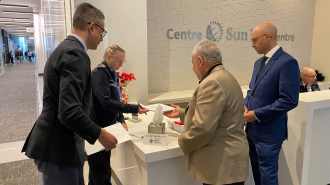Broken Bonds: The existential crisis of Egypt’s Muslim Brotherhood
Despite being one of Egypt’s largest and most influential organisations, and in spite of having been part in one way or another of each and every major historical event that has occurred in the country over the past nearly 100 years, the Muslim Brotherhood, its internal affairs and its decision-making processes remain poorly known and understood.
The book Broken Bonds: The Existential Crisis of Egypt’s Muslim Brotherhood, published in February by Century International, fills this gap in depth and dives with great insight into the tectonic shifts that the organisation has undergone between 2013 and 2022.
Delving into these internal dynamics, and trying to grasp how they are shaping the future of the organisation, is particularly timely now.
The group is currently at an existential crossroads as it copes with a decade of unprecedented repression while in the midst of yet another reconstitution process that opened with the election in March of a new acting leader, Salah Abdulhaq, to succeed the historic Ibrahim Mounir, who passed away in November.
"The authors trace how the group’s stances have often tended to combine radical positions directed at its populist base on the margins with more reformist and moderate proposals appealing to the middle classes and the West"
The authors of the book could not be better placed to take on the task of introducing the reader to this complex reality, not only through their own personal experience but also through perhaps unparalleled access to senior, junior and former members of the organisation as well as internal documents.
They are Abdelrahman Ayyash, director of Century International’s Egyptian Muslim Brotherhood working group, Noha Ezzat, a writer and researcher specialising in Egypt, Turkey and Iran, and Amr ElAfifi, whose work focuses on the relationship between trauma and political participation.
The authors approach the Muslim Brotherhood not as a mass ideological organisation, as is often the case in some internal and external circles, but as an elite social organisation. And one of the most compelling aspects is the angle from which they analyse this group since they do not make their study revolve around the “Muslim” part of the equation, but rather around its “Brotherhood” side: the interactions between members and leaders, and the feelings of fraternity and belonging as key elements to understand the organisation.
The main conclusions put forward are that the Muslim Brotherhood is going through a triple crisis of identity, legitimacy and membership. And they argue that while these crises have been exacerbated since the crackdown unleashed in 2013, the roots go back further.
The book appeals to all audiences as it provides the necessary historical context on the Egyptian Muslim Brotherhood before delving into this triple crisis.
This includes how the organisation has responded, adapted, and forged an image of itself throughout the social and political changes that the country has seen –including in levels of repression– since the group’s establishment in 1928 and up to the present. It also provides a good overview of its tangled organisation at both the hierarchical and territorial levels.
This context is important to better understand how one of the key factors explaining the identity crisis of the Egyptian Muslim Brotherhood is the organisation’s tactical responses to the authoritarian and competitive pressures it has faced almost since its foundation.
These have also largely reflected the tight control exercised for decades by members of the organisation hailing from its secretive Special Apparatus of the early days of the group
The authors argue that while these responses have been useful in ensuring the survival of the organisation, the fact that they have traditionally had to react to external pressures rather than take the lead has also diluted its more political ethos, undermined its ability to act as a national actor, and ultimately limited its ability to forge a definition of itself.
"The success of the Islamic resurgence that followed turned the religious element in itself into one too generic to differentiate them from the others, and even raised doubts about the role the organisation then wanted and could play"
Ideologically, the authors trace how the group’s stances have often tended to combine radical positions directed at its populist base on the margins with more reformist and moderate proposals appealing to the middle classes and the West – again reacting rather than being proactive.
This has shown flexibility from its side but has projected vague narratives and intentions, an image of hesitation, and has contributed to blurring a coherent political project, which proved especially problematic in the aftermath of 2011.
A glaring example of this crisis of identity is religiosity. Here, the authors notice that personal religiosity may have been a sign of potential support for the Muslim Brotherhood back in the 1970s.
But they argue that the success of the Islamic resurgence that followed turned the religious element in itself into one too generic to differentiate them from the others, and even raised doubts about the role the organisation then wanted and could play.
The section devoted to the organisation’s legitimacy crisis dissects in great detail the deep internal divisions that the Egyptian Muslim Brotherhood experienced after the coup in 2013.
It also delves into the different internal structures that were created as a result of the years that followed, as well as the ways in which these splits affected the day-to-day operations (and life) of the group from its leadership to its rank and file.
The first major conflict within the organisation took place between 2014 and 2016 and involved the factions of the so-called historical leadership formed by the triad of Ibrahim Mounir, Mahmoud Hussein and Mahmoud Ezzat, and that of Mohamed Kamal, a more recent Guidance Bureau member in 2013.
At the heart of the dispute, the authors argue, were totally different –and sometimes opposed– views on such crucial issues as the best way to oppose the new regime, the group’s identity, and the role it should play in society.
|
While Kamal’s faction took a revolutionary stance that was betting on changing the status quo as quickly and profoundly as possible, the faction of the historic leadership embraced a stance of gradual change more in line with what the Muslim Brotherhood has traditionally come to epitomise. By the end of 2015, the latter eventually prevailed.
The second of these major feuds broke out in the mid-2020s, following the surprising arrest of Mahmoud Ezzat in Egypt, pitted Mounir against Hussein and is still in some respects unresolved.
Unlike the previous one, however, this was not a battle over ideas but rather one of power – the result not so much of the individuals involved per se but above all of the lack of institutionalisation of the organisation, and what this entails at the level of for instance transparency and accountability.
The membership crisis, in turn, is essentially a reflection of the two preceding crises of identity and legitimacy and stems from multiple reasons: the feeling among young cadres of having been sold out by the leadership after having risked everything, the sense of abandonment resulting from internal feuds, the effects of unprecedented exiles.
Also the frustration in the face of the impossibility of pushing for internal reform, of being left aside in the decision-making processes, the shattered fraternity, the feeling of having become an inefficient organisation, and perhaps the inevitable questions on theodicy.
Although the review of the history of the Egyptian Muslim Brotherhood is sharp and the diagnosis of its three main crises is concerning for its interests, the authors suggest that one would be deluded to think that many of the challenges the organisation has faced are unique to it and have not also been encountered by other social and political groups in the country, including the state itself – and often with equal if not less success.
In fact, the authors consider that the Egyptian Muslim Brotherhood is facing an existential crisis. But at the same time, they argue that it is premature to declare them irrelevant or even over, largely because an eminently securitised approach to countering the group is short-sighted. And because its popularity derives in great part from a well-rooted tradition of Islamic political thought and the state’s failures to deal with the problems of its citizens.
Marc Español is a Catalan journalist based in Cairo.
Follow him on Twitter: @mespanolescofet

![Mahmoud Ezzat (blue), the former supreme guide of Egypt's Muslim Brotherhood, attends his sentencing during a trial session at the Tora courthouse complex [Getty Images]](/sites/default/files/styles/medium_16_9/public/2023-05/GettyImages-1240979923.jpg?h=3ac079aa&itok=hOp9ZnlM)






 Follow the Middle East's top stories in English at The New Arab on Google News
Follow the Middle East's top stories in English at The New Arab on Google News


